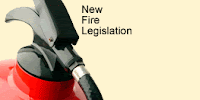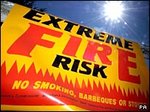A
* Above-ground storage tank: Storage tank that is not buried. Compare Underground storage tank. Unburied tanks are more prone to physical damage, and leaks are released to the air or ground, rather than the soil surrounding a buried tank.
* Accelerant: flammable fuel (often liquid) used by some arsonists to increase size or intensity of fire. May also be accidentally introduced when HAZMAT becomes involved in fire.
* Accountability: The process of emergency responders (fire, police, SAR, emergency medical, etc...) checking into and making themselves announced as being on-scene during an incident to an incident commander or accountability officer. Through the accountability system, each person is tracked throughout the incident until released from the scene by the incident commander or accountability officer. This is becoming a standard in the emergency services arena primarily for the safety of emergency personnel. This system may implement a name tag system or personal locator device (tracking device used by each individual that is linked to a computer).
* AFA: Automatic Fire Alarm/Actuating Fire Alarm
* Alarm: (1) system for detecting and reporting unusual conditions, such as smoke, fire, flood, loss of air, HAZMAT release, etc; (2) a specific assignment of multiple fire companies and/or units to a particular incident, usually of fire in nature; (3) centralized dispatch center for interpreting alarms and dispatching resources. See fire alarm control panel.
* All companies working: Status report at fire scene indicating that available manpower is busy, and more resources may become necessary if incident is not controlled soon.
* Ammonium nitrate: component of ANFO; contents of two ships that exploded in Texas City Disaster, killing over 500 people, including all 28 volunteer firefighters at the scene.
* ANFO: Ammonium Nitrate Fuel Oil combination making a high explosive.
* Apparatus: A term usually used by firefighters describing a piece of equipment, usually a company vehicle.
* Arson: the crime of maliciously (or perhaps recklessly) setting fire to property, especially a dwelling. Punishable in various degrees, depending upon the circumstances. Occasionally occurs as a psychotic act of a mentally ill firefighter.
* Authority Having Jurisdiction (or AHJ): organization or agency with legal authority over a given type of incident (e.g, fire, EMS, SAR, arson, HAZMAT); may change or overlap as incident changes, as where fire becomes arson investigation once danger is over, or Motor Vehicle Accident becomes police business after vehicle extrication, fire, and HAZMAT issues are complete.
* Autoextended fire: structure fire that has gone out a window or other opening on one floor and ignited materials above, on another floor or other space (attic, cockloft).
* Available flow: total amount of water that can be put on a fire, depending upon water supply, pump size, hoses, and distance to the fire. IC must assess available flow to determine whether additional apparatus or streams are required. See Fire flow requirement.
B
* BA Set: Breathing Apparatus Set comprising of a face-mask and oxygen cylinder
* Backdraft: A fire phenomenon caused when heat and heavy smoke (unburned fuel particles) accumulate inside a compartment, depleting the available air, and then oxygen/air is re-introduced, completing the fire triangle and causing rapid combustion.
* Backfiring: A tactic used in wildland firefighting associated with indirect attack, by intentionally setting fire to fuels inside the control line. Most often used to contain a rapidly spreading fire, placing control lines at places where the fire can be fought on the firefighter's terms.
* Back burning: Australian term, for Backfiring, above.
* Backflow preventer: Automatic valve used in hose accessories to ensure water flows only in one direction. Used in permanent fire department connections (FDC) to sprinklers and dry standpipes, as well as portable devices used in firefighting.
* Bank down: What the smoke does as it fills a room, banks down to the floor, creating several layers of heat and smoke at different temperatures -- the coolest at the bottom.
* Boiling liquid expanding vapor explosion (BLEVE): Explosion of a pressure tank containing an overheated material when the vapor expansion rate exceeds the pressure relief capacity (e.g., steam boiler or LPG tank). If the contents are flammable, the rapidly released vapor may react in a secondary fuel-air explosion.
* Box (Alarm): A mailslot or other file system containing a notecard with a planned response to an incident type. For example, a reported structure fire on Some Road would be tagged with Box 6; the notecard in Box 6 would contain the list of apparatus from various fire stations that should be dispatched to that incident. Assigning Boxes to areas (or even specific structures) significantly facilitated the process of getting the right tools to the right place on the initial dispatch, and helped eliminate the guesswork of "which department has what" on the fire scene. Boxes later evolved to contain escalation procedures - on the "2nd alarm", the Box would contain the next group of apparatus from various fire stations, etc. Modern CAD systems now abstract the Box Alarm concept, and allow box definitions to be triggered based on arbitrary geographic area, time of day, incident type, weather, and any other planned situation. For a given hydranted area, the "Summer" box will contain the usual response of Engine, Truck, and Rescue companies. In the winter, however, the box may be modified (automatically, or manually) to include Water Tankers on the initial dispatch, to handle the case of frozen hydrants. The term "Box" comes from the fire alarm pull boxes that were commonplace in major cities for well over fifty years. This was a telegraph system that involved bells to ring out the box number. This system was in place from the 1920's (or earlier) to well into the 1960's and 1970's in some cities. Boston was one of the first (if not THE first) major U.S. Cities to have a telegraph alarm system. They installed it in 1852. The Boston Fire Department STILL USES this system of paper rolls and bells. The modern use of "box cards" based upon an imaginary box location for dispatch or move up is often known as the "Phantom Box System".
* Bus* another term for ambulance,
* Bushfire: Australian term, for Wildfire, below.
C
* Call Firefighter: Call firefighters respond as needed on a part time basis to all types of emergencies. Call firefighters train with their local engine companies in their districts. Call firefighters are utilized in three different ways. “First Responder" call firefighter units, are those units that are staffed entirely by paid call firefighters. These firefighters respond to all emergency incidents within their jurisdictional areas and are supported by full-time companies from adjoining jurisdictions. "Supplemental" call firefighter units are those units that staff a second engine company from a station that is also staffed by a full-time company. These units respond to all multi-unit responses in their district, and cover the station when the career companies are committed. "Augmentation" call firefighters are assigned to an existing career company and respond directly to the scene to augment that company's staffing.
* Career Firefighter: A person whose primary employment is as a firefighter for a municipality or other agency or company and who derives the majority of his earned income working in the fire service.
* Charge a hose: To make water pressure available on a hose in final preparation for its use. This is done on the scene after the hose is deployed.
* Charged hose: A hose that is filled with water and pressurized; ready to use. This is done after the hose is deployed.
* Chauffeur: See Engineer.
* Chimney fire: Fast and intense fire in a chimney flue in which accumulated creosote and other combustion byproducts ignite.
* Class A: A fire involving combustibles such as wood, paper, and other natural materials. See Fire Classes.
* Class B: A fire involving hydrocarbons. See Fire Classes.
* Class C: An electrical fire. See Fire Classes.
* Class D: A fire involving metals, such as sodium, titanium, magnesium, potasium, uranium, lithium, plutonium and calcium. See Fire Classes.
* Class E (Europe/Australia): A composite Class A/Class B fire that is not also a Class C fire.
* Class F (Europe/Australia): See Class K.
* Class K: A fire involving cooking oils. Technically, this is a subclass of Class B. See Fire Classes.
* Cockloft: structural space above ceiling and below rafters, often connecting adjacent occupancies and permitting fire to spread laterally, often unseen.
* Collapse zone: The area around a structure that would contain debris if the building were to collapse.
* Combustion:
* Company: two or more firefighters organized as a team, led by a fire officer, and equipped to perform certain operational functions. Compare with platoon and unit.
* Compartment Fire: An "Isolated" fire, or a fire which is "boxed in" or "closed off" from the rest of the structure. An example of this is a fire in a room where all the windows and doors are closed preventing the fire from spreading to other rooms.
* Confined space:
* Conflagration: a large, typically urban, fire involving numerous structures; loosely defined as enveloping an area equivalent to one or more square blocks. Compare with firestorm.
* Crash Tender: a pump capable of spraying foam used at airports.
* Cross lay: Arrangement of hose on a pumper such that it can be quickly unloaded from either side of the apparatus; often pre-connected to a pump outlet and equipped with a suitable nozzle. Also know as Mattydale Lay.
By Wikipedia
Compliant With New Fire Laws ?
If you're not, then Fire Sense UK is here to help you.
Due to an increase in our sponsorship we are offering free use of our services for a limited period. Your free account runs for one month and does NOT require a credit card to activate.
Sign Up / Register
Thursday, July 5, 2007
Glossary of Fire Fighting Terms (A to C)
Posted by
Fire Risk Assessments
at
6:43 AM
![]()
Labels: Fire Fighting, Fire Rescue Services, Fire Risk, Fire Risk Assessments, UK Fire
Subscribe to:
Post Comments (Atom)
Wikipedia Fire Risk Links
- Fire Academy Online
- Fire Fighting Academy
- Fire Fighter Academy
- National Fire Academy
- Fire Academy
- Fire Station UK
- Fire Alarm System UK
- Gas Fire UK
- Electric Fire UK
- Fire Alarm UK
- Fire Prevention Product
- Fire Prevention Protection
- Fire Prevention Week
- Fire Prevention Safety
- Fire Prevention
- Fire Extinguisher Supplier
- Home Fire Extinguisher
- Fire Extinguisher Service
- Fire Extinguisher Type
- Fire Extinguisher
- Assessment Fire Form Risk
- Assessment Fire Risk Safety
- Assessment Fire Risk
- Fire Life Safety
- Fire Safety School
- Fire Product Safety
- Fire Monitoring Safety
- Fire Safety Tip
- Fire Safety Video
- Fire Safety Sign
- Fire Safety Training
- Fire Safety Tip
- Equipment Fire Safety
- Fire home Safety
- Fire Kid Safety
- Fire Prevention Safety
- Fire Safety
- Fire Safety Risk Assessment
- Assessment Fire Risk
- Fire Risk
- Fire Risk Assessment



3 comments:
Learn few fine points of software editing with numerous tutorials that are simply accessible with few simple clicks.
Well-mannered, handsome men, looking forward to earn some money, can apply online to Men2hire for.
By looking at funny pictures and funny dog videos on the internet, the hours will
slip away easily.
Feel free to surf to my web page funny pictures at walmart
After I originally commented I appear to have clicked the -Notify me when new comments are added- checkbox and now whenever a
comment is added I recieve 4 emails with the same comment.
Is there a way you are able to remove me from that service?
Thanks!
Feel free to surf to my blog; celebrity news
SNG Fire are leading UK based fire risk assessors, qualified to carry out fire risk assessments. We provide a nationwide Fire Risk Assessment service starting from as little as £135.
Fire Risk Assessments
Post a Comment